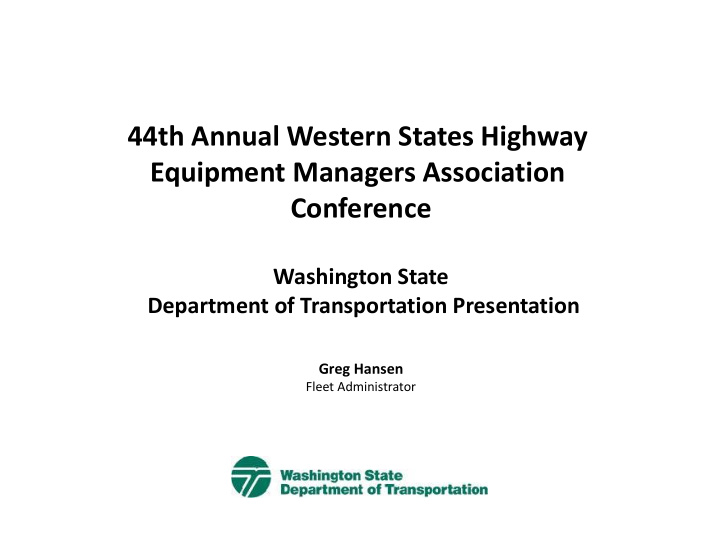



44th Annual Western States Highway Equipment Managers Association Conference Washington State Department of Transportation Presentation Greg Hansen Fleet Administrator
Equipment Plays a Critical Role in Operating and Maintaining The Highway System 2 2
How TEF Works 1. The Transportation Equipment Fund (TEF), is a revolving fund. 2. TEF has been a revolving fund since 1935 3. TEF calculates the biennial cost to fuel, service and maintain all equipment and replace equipment that has reached the end of it’s service life. 4. TEF receives expenditure authority from the Legislature 5. The Legislature appropriates funds to WSDOT programs. 6. TEF receives funds by charging WSDOT programs “rent” for the use of vehicles and equipment. The rent collected is equal to the anticipated costs for the biennium. 7. Because it is a revolving fund, cash balances may move across biennial lines. 3
TEF Equipment 4,800 Vehicles & Construction Equipment 10,000 Pieces of Supporting Equipment 4,500 - Wireless Radio System Components 500 - Field Engineering Survey Equipment 1,350 - Equipment Attachments (primarily snow and ice) 1,700 - Materials Lab Testing Equipment 410 - Fuel System Components and Generators 1,110 - Message Signs and Impact Attenuators 40 - Reproduction and Photogrammetry Pieces 390 - Equipment and Lab Trailers 4
5
Expenditures Planned For The 13-15 Biennium $145.8 Million To Deliver Essential Program Services (All dollar amounts are in thousands) Labor $30.3 209.3 FTE Outside Services $3.1 Includes glass replacement, body work, radio installation, fuel site service and repairs, man lift inspections and repairs and power generation maintenance. Other $3.3 Supplies and materials; motor oil and other petroleum products; propane; safety items to include clothing and footwear; laundry; fleet management software and licenses; fuel management software and licenses; towing; tool replacements; travel and per diem. Fees to other Agencies $0.6 GA disposal, Attorney General, Risk Management, Department of Licensing Capital $49.4 Fuel $48.5 Repair parts $10.7 $145.8 6
Work Force 209.3 FTE Authorized a 16 Accounting and Administrative Staff a 13 Repair Parts Specialists a 145 Mechanics a 15 Radio Technicians 7
Doing More … With Less 8
Fuel Usage and Cost 9
The Fleet is Aging The program’s goal is to maintain the inventory at 50 percent of its economic life, that is, the average age of any particula r equipment class should be half of the class’ established replacement schedule. A level purchasing methodology is applied to accomplish this goal, whereas the amount of units replaced annually is relatively consistent. For example, an equipment class containing 400 units, on a ten-year replacement schedule, should have 40 units replaced each year to turn the entire class inventory in its ten-year period. Average Age of Units in Years Vehicle Classification 2012 Unit Avg. Lifecycle Target 2007 2008 2009 2010 2011 2012 Count (years) Avg. Age Passenger Vehicles 545 12.0 6.0 4.6 5.1 5.3 6.1 6.0 6.8 Highway Maintenance Work Vans 157 12.0 6.0 4.3 3.7 4.4 5.2 5.8 6.6 Highway Maintenance Work Trucks 1252 11 5.5 4.0 4.2 4.7 5.6 5.8 6.3 Dump Trucks / Snow Plows 476 12 6 5.1 6.0 5.8 5.4 5.3 5.4 Snow Removal Equipment 921 11 5.5 4.8 5.1 5.2 5.2 5.1 5.5 Man lifts / Digger Derricks 106 11 5.5 4.7 4.7 5.1 5.7 6.1 6.4 Specialized Heavy Trucks 271 11 5.5 6.1 6.0 5.9 6.4 6.5 6.6 Highway Construction Drilling Equipment 26 12 6 5.0 4.8 5.4 5.5 6.0 6.0 Equipment Trailers 339 15 7.5 6.7 6.8 7.4 8.1 8.5 8.7 Motor Graders 35 20 10 7.3 7.9 8.2 9.2 10.2 11.2 Excavators 28 15 7.5 9.1 9.0 8.9 9.9 10.2 10.8 Loaders 203 20 10 7.0 7.2 8.2 9.0 9.9 10.9 Rollers 30 20 10 9.3 9.6 10.6 11.6 12.6 12.2 Sweeping Equipment 62 11 5.5 4.8 4.2 5.1 5.9 6.7 6.6 Safety Message Signs 795 10 5 4.4 4.1 3.9 3.5 3.8 4.4 Emergency Generators 197 20 10 6.3 7.2 8.0 8.9 9.8 10.6 Mowing Equipment 235 11 5.5 4.2 4.9 5.3 6.1 6.7 6.9 Misc. Road Maintenance Equipment 504 10 5 5.5 5.9 6.5 7.1 7.7 8.2 10
Aging the Fleet A Tale of Two Trucks Plow Truck Comparison Avg. Yearly Repair Costs Average Labor Hrs Average DownTime 12 Year Old Plow Truck $13,616 172 26% (Data based on 19 trucks) 14 Year Old Plow Truck $21,492 250 44% (Data based on 15 trucks) ($7,876) (78) -17% Data from Jan.-Dec. 09 Things You Don’t See 12 Year Old Plow Truck Worn Out Brake and Electrical Parts 11
Risks Associated with Aging the Fleet Equipment availability will go down Unreliable equipment effects the ability of Maintenance and Construction delivering their programs Longer response times Potential to adversely affect the traveling public and Efficiency decline in day to day operations freight mobility 12
Fuel Additives • Energy conservation and air quality concerns continue to be significant issues for our agency. Over the years, policies have been developed and implemented to ensure that limited resources are utilized in the most cost-effective, efficient manner possible. • Therefore, results of third party analysis and testing of new products, devices and technology for fuel savings and emission reductions must be provided by the vendor(s) prior to implementing the use of a new products, devices and technology with regards to the agency’s fleet and equipment. Prior to using a new fuel additive or fuel and emission reduction device and technology, testing and product evaluation from the U.S. Environmental Protection Agency’s (EPA) “Gas Saving and Emission Reduction Devices Evaluation” program is required. WSDOT will review the evaluation and determine if the product merits field testing. • The link to the EPA’s “Gas Saving and Emission Reduction Devices Evaluation” program is http://www.epa.gov/otaq/consumer/reports.htm. 13
Questions? Contact: Greg Hansen - Title: Fleet Administrator - Phone: 360-491-2453 - Email: Hanseng@wsdot.wa.gov 14
Recommend
More recommend